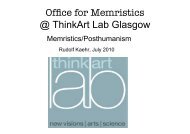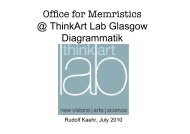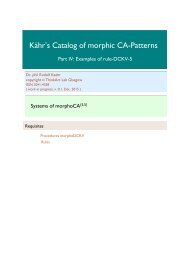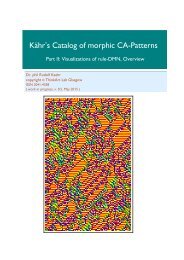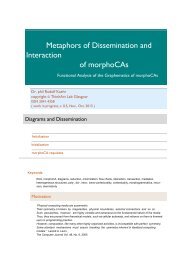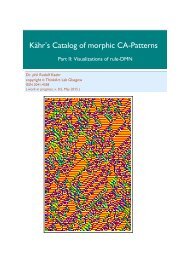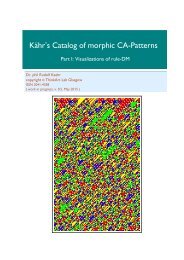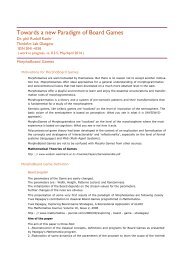A Kind of a New Music Box
A Tool Box for sonic and visual deep-structural adventures by comparing classical, indicational and morphic CA. Motto: If words are not going to be listened to and notions are not going to be understood, there is still a chance of showing some pictures and making some noise, with an offer to motivate to enjoy or to conceive their differences and also to try to overcome the attitude of blind and deaf denial of conceptual thinking. Interactivity for Sound and Visualizations needs the formats Wolfram CDF or HTML. http://www.thinkartlab.com/Memristics/PPSVB-Plus/PPSVB.x11D-Plus.html , soundtracks at: https://soundcloud.com/morphicalgorithms/tracks, more information at: http://the-chinese-challenge.blogspot.co.uk
A Tool Box for sonic and visual deep-structural adventures
by comparing classical, indicational and morphic CA.
Motto:
If words are not going to be listened to and notions are not going to be understood, there is still a chance of showing some pictures and making some noise, with an offer to motivate to enjoy or to conceive their differences and also to try to overcome the attitude of blind and deaf denial of conceptual thinking. Interactivity for Sound and Visualizations needs the formats Wolfram CDF or HTML. http://www.thinkartlab.com/Memristics/PPSVB-Plus/PPSVB.x11D-Plus.html , soundtracks at:
https://soundcloud.com/morphicalgorithms/tracks, more information at: http://the-chinese-challenge.blogspot.co.uk
Create successful ePaper yourself
Turn your PDF publications into a flip-book with our unique Google optimized e-Paper software.
PPSVB.x11D-Plus.cdf 5<br />
Morphogramatics<br />
The morphogrammatical way <strong>of</strong> writing and thinking, introduced by Gotthard Gunther with his “Cybernetic<br />
Ontology and Transjunctional Operations,(1962), is as such well elaborated by the publication “Morphogramatik”,<br />
Kaehr, Mahler (1993), and got a some controvert reception from the side <strong>of</strong> mathematicians, logicians, semioticians<br />
and cyberneticians.<br />
Morphograms had been introduced by Gunther as pre-logical patterns (morphé) <strong>of</strong> trans-classical logics. As prelogical<br />
and pre-semiotic figurations morphograms are in fact figures and rules at once, i.e. as figurations or<br />
structurations. The dynamic aspect <strong>of</strong> morphograms as rules is implemented in the paradigm <strong>of</strong> morphoCA.<br />
In his theory <strong>of</strong> cybernetic self-reflection, Gunther classified the 15 basic morphograms into 3 classes:<br />
1. Acceptance: objective reflection represented by the morphograms MG (4,2) ,<br />
2. Rejectance: subjective reflection represented by the morphograms MG (4,3) ,<br />
3. Refutation: self-reflection as reflection on 1) and 2) by MG (4,4) .<br />
In the context <strong>of</strong> cybernetic studies <strong>of</strong> dynamic systems, this classification had also been interpreted in the 1960s<br />
by Henz von Foerster as order principles.<br />
Cybernetic Dynamics<br />
1. Order from order,<br />
2. Order from disorder,<br />
3. Order from noise (order and/or disorder).<br />
A new graphematic principle <strong>of</strong> order and creativity might be added as:<br />
4. Order from (neither order nor disorder).<br />
Because this cybernetic research into automata theory happened in the early 1960s, it wasn't mainly computer<br />
supported.<br />
Definitions<br />
How GSB sounds might be listened at the register CI, is orchestrated by ruleCI.<br />
The further CI concepts, CIR, RCI and CIRT, had been freely introduced by the author in previous papers.<br />
The rule set CI, defines the objectional definition <strong>of</strong> the Calculus <strong>of</strong> Indication (CI), a reflection on CI generates a<br />
second-order CI, i.e. the RCI, with its genuine new rules.<br />
Further reflectional thematizations <strong>of</strong> the CI generates a third-order calculus RCI, and its augmentation CIRT.<br />
Indicational CAs are thus divided into:<br />
a) first-order indCA (in the sense <strong>of</strong> the Calculus <strong>of</strong> Indication (CI), ruled by the set <strong>of</strong> ruleCI,<br />
b) as second-order (enactional) rules ruleCIR,<br />
c) as third-order rules ruleRCI, and<br />
d) the rules <strong>of</strong> ruleCIRT.<br />
Rule schemes for indicational CA<br />
ruleCIa_, b_, c_, d_ :=<br />
Flattenrci[{a}], rcib, rci[{c}], rcid<br />
ruleCIRa_, b_, c_, d_, e_, f_, g_, h_, i_, k_ :=<br />
Flatten<br />
cir[{a}], cirb, cir[{c}], cird,<br />
cir[{e}], cirf, cir[{g}],<br />
cirh, ciri, cirk<br />
ruleRCIa_, b_, c_, d_, e_, f_, g_, h_, i_, j_,<br />
Flatten<br />
k_, h_, l_, m_, n_, o_, p_, q_, r_, s_ :=<br />
rci[{a}], rcib, rci[{c}], rcid,<br />
rci[{e}], rcif, rci[{g}], rcih,<br />
rcii, rcij, rcik, rcih,<br />
rcil, rci[{m}], rci[{n}], rci[{o}],<br />
rci[{p}], rci[{q}], rci[{r}], rci[{s}]



